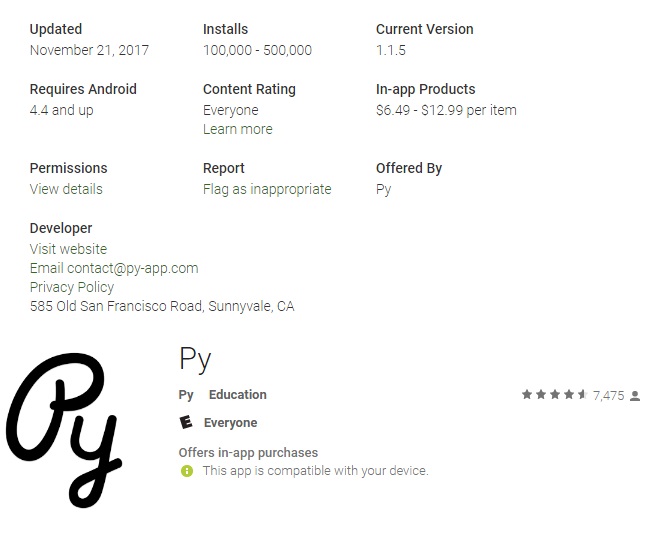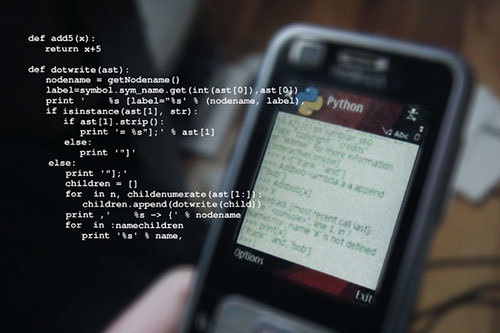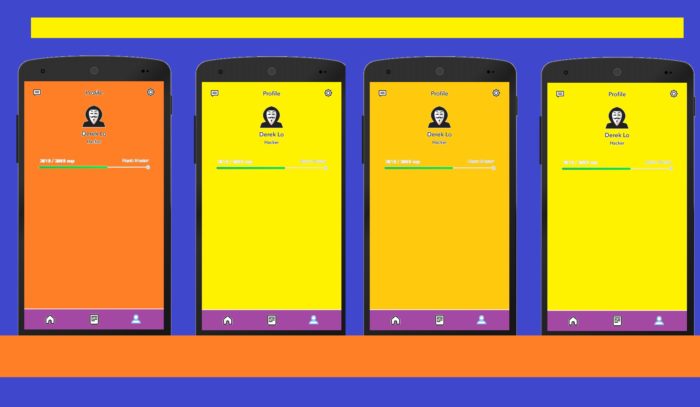NEW YORK, NY (PRWEB)- According to the White House, by 2018, 51 percent of STEM jobs will be in computer science-related fields. However, the number of tech employees has not increased along with the number of jobs available. Why? The answer is simple: lack of relevant education. The White House maintains that just one quarter of K-12 schools offer high-quality computer science with programming and coding. In addition, in 2016, the PEW Research Center reported that only 17% of adults believed they were “digitally ready.” Technology is changing the way that we live and work, and it’s happening fast. So how do we ensure that individuals (especially girls and women) are digitally literate?
In my new interview below with C.M. Rubin (founder of CMRubinWorld), Derek Lo says he started Py because he wanted to demystify “coding”. His app does this by making coding fun. The program also avoids using any programming jargon until the learner is ready. Lo states that “gamification isn’t a hindrance to learning—-it accelerates it.” He further notes that coding “instills a greater aptitude for systematic thinking and logical decision making.” Lo recently partnered with the not for profit Girls Who Code to further reduce the gender gap and “change people’s image of who a coder is.”

“We specifically write our content using language that even young children can understand.” — Derek Lo
Why were 600,000 high-paying tech jobs unfilled in 2015 in the United States alone, or is the better question: Is technology developing faster than humans can learn to handle it?
When we look at diversity, things only get worse. In 2015, 22 percent of students taking the AP Computer Science exam were girls while 13 percent were African-American or Latino. These statistics are not U.S. specific; in 2015, Australia reported that only 28 percent of ICT jobs were held by women.
Coding has always been regarded as a mysterious field, something Derek Lo, co-founder of the new application “Py”, wants to change. Launched in 2016, the application offers interactive courses on everything from Python to iOS development. The “unique value proposition,” as Lo puts it, has been a revolutionary success. The fun-oriented application has so far resulted in over 100,000 downloads on both iTunes and Google Play.
Most parents frown when kids use their phones at the dinner table, but what if the kids were learning to code over Sunday roast? “Ok, so maybe not the Sunday roast, but seriously, could a more accessible and fun coding application make all the difference?”
The Global Search for Education is excited to welcome one of Py’s founders, Derek Lo, to discuss how Py’s revolutionary approach is literally making coding cool.

“Coding can provide people with the awesome ability of being able to create tangible things like websites and apps. It also instills less tangible things like a greater aptitude for systematic thinking and logical decision making.” — Derek Lo
People say education today is often treated as a business and that individual students’ needs have not been prioritized enough. As the number of qualified applicants increases, can individualized learning tools, such as Py, help today’s generations remain competent in our globalized world, even with “broken” education systems?
Yes. As college acceptance rates decline, more people will need alternatives for learning career-essential skills, and we believe Py will be a big part of that. Using machine learning algorithms, we’re able to adapt the user experience based on prior skill and behavior within the app, creating a tailored curriculum. Having a personal tutor in your pocket that knows how you learn and what you should be learning is powerful and why we are investing in personalization.

Py provides its users with a simple and easy platform while many other coding applications (e.g. Solo Learn) have opted for more traditional and serious lesson plans. Does making learning applications appear more serious fuel the conception that coding is a hard and scary thing to learn? Are we over-complicating the field of coding and making it seem inaccessible for people or should students really be this wary of programming?
One of the reasons that my co-founder and I started Py is to demystify “coding”. We make it easy by making it fun. When you’re dragging pretty blocks around and pressing colorful buttons, it doesn’t feel like work. Yet users are still soaking up all the same knowledge they would be by slogging through a boring textbook. We also intentionally avoid programming jargon until the learner is ready. A good example is when we teach users about loops—-we use words like “repeat” instead of “iterate”. Almost all of Py’s courses are focused on teaching the fundamental concepts using simple language and in an interactive fashion.
Also, many people are scared away from learning how to code because they hear from friends that computer science is such a difficult major in school. An important thing to realize is that there’s a big difference between theoretical computer science and making a simple website. An art major might not need to understand Dijkstra’s algorithm, but would greatly benefit from knowing a bit of HTML and CSS.

“We’re extremely excited about helping to change people’s image (and self-image) of who a coder is and actively encourage more girls to get into coding.” — Derek Lo
What would you say to skeptics who question whether a game-like application like Py can truly help people learn how to code properly?
Gamification isn’t a hindrance to learning—-it accelerates it. By keeping you excited and engaged, Py teaches you better than if you got bored or zoned out. When you’re having fun, you actually learn faster and better.
Another way to phrase this question might be, “Even if Py is fun, do you walk away having learned something from it?” The answer is yes, definitely. We’re very data-driven, constantly improving our courses by analyzing our users’ progress. We can see (and track) real progress in our users’ ability to understand everything from basic semantics to high-level algorithms and design principles.
Do you think Py’s game-like surface allows younger generations to become more involved with coding?
Yes. We specifically write our content using language that even young children can understand. In fact, a parent emailed us just the other day telling us he was using Py to teach his 10-year old son Python! Currently our target demographic is definitely a bit older than that though. We think of Py as the learn-to-code solution for the SnapChat generation.
What general skills does coding teach kids/ young adults?
Coding can provide people with the awesome ability of being able to create tangible things like websites and apps. It also instills less tangible things like a greater aptitude for systematic thinking and logical decision making.

“Once you understand how an algorithm works, typing it out should be an afterthought. The important thing is to understand it—once you do, it’s yours forever.” — Derek Lo
Py has recently partnered with Girls Who Code. Why do you think coding has been branded throughout history as a ‘male’ profession and how do you hope to eliminate this gender gap?
Historically some of the most important computer scientists are women. Ada Lovelace and Grace Hopper are considered pioneers of programming. Stereotypes aside, men and women are obviously equally capable of becoming great software engineers. We’re extremely excited about helping to change people’s image (and self-image) of who a coder is and actively encourage more girls to get into coding. We’re huge fans of Girls Who Code and we’re so excited to provide them free premium subscriptions for some of their students.
When we think of coding, we mostly envision computer screens, yet we tend to use our phones more often than we do our computers. How does Py bridge the gap between using a computer screen as opposed to learning how to code on smaller devices? Is the coding world shifting to using smartphones or is coding still a generally ‘computer’ based field?
People actually don’t need to type lots of code to learn the concepts necessary to become great programmers. We’ve built interaction types like “fill-in-the-blank” that let users quickly edit code on the fly without any typing. Recently we’ve also created a custom keyboard that allows users to type real code on their phones in a friction-less way. This is great for short programs and practicing the fundamentals, and it’s how we’re making the transition from computer to phone and vice versa easier. Applying this knowledge to create a website or app does still primarily take place on computers. But the world is seeing a wave of new mobile learning applications, and I think we’re at the forefront of that trend.
How do you envision the world of coding changing in the next 15-20 years? How will Py keep up with these changes in the field?
Coding will become less about rote memorization of basic syntax and more about high-level understanding of what’s really going on. At a minimum, programming languages have morphed from low-level (shifting bits and allocating memory) to high-level (abstract data structures and functional programming), from obtuse (assembly, machine code) to human friendly (Python, Swift).
That’s why Py focuses on high-level concepts. Once you understand how an algorithm works, typing it out should be an afterthought. The important thing is to understand it—once you do, it’s yours forever.

(All photos are courtesy of CMRubinWorld except featured image by J. Barker)
For the Silo, David Wine /CMRubinWorld with contributions by Zita Petrahai.
